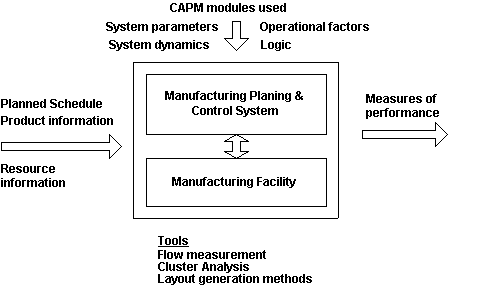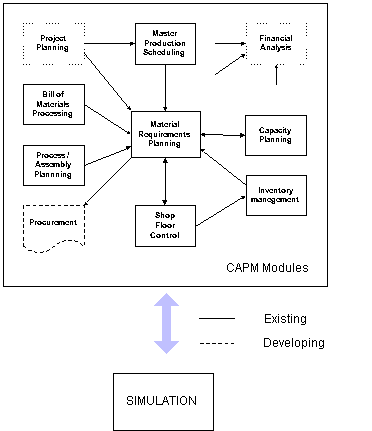Simulation of Manufacturing Systems
Dr Christian Hicks Department of MMM
Engineering,
|
 |
Simulation of Manufacturing Systems
Dr Christian Hicks Department of MMM
Engineering,
|
 |
In the literature, the simulation of manufacturing systems has either been predominantly concerned with relatively simple facilities such as job shops, batch production facilities or floweriness. In general, this work has focused on detailed issues such as the evaluation of layout, or the selection of dispatching or lot sizing rules. Other research has adopted an aggregate approach, with severe simplifying assumptions, in which important details may have been neglected.
In our work at Newcastle, a large-scale, simulation model, that allows entire manufacturing facilities to be represented has been developed for investigating manufacturing systems issues. It may be used as a research tool, or it may be used as a planning tool that allows plans to be generated and validated by simulation. The model represents a manufacturing facilities under the control of a manufacturing planning and control system (see figure 1).

Figure 1 Manufacturing System Simulation Model
The Manufacturing System Simulation Model is based upon the discrete event paradigm (Kreutzer, 1986). It has the capability to represent the manufacture of a range of product families with either shallow or deep product structure using jobbing, batch, flow and assembly processes. The model was developed without reference to any particular site and can be configured at run time to represent a specific company using a series of user-friendly forms. The model provides an integrated framework for investigating manufacturing systems problems. Data on the facilities, current schedules, product information such as product structures and process plans are required as input. A very wide range of issues may be investigated and evaluated in terms of a specified performance criteria. For example:

Figure 2 Computer Aided Production Management Modules
Implementation
The model is written in a modular style using Pascal,
C,
XView
and Tk-Tcl and runs on Sun workstations with
the Solaris UNIX operating system. It is designed to support multiple simultaneous
users who may each run many different models concurrently. The simulation
program does not limit the size of model. The amount of computer memory
limits the number of items that can be produced and the processing power
determines the time taken to do each run. It has been found that even an
entry-level UNIX workstation is capable of modelling typical engineer
to order / make to order facilities. The program employs dynamic data
structures based upon trees, double linked lists and dynamic matrices which
are implemented using pointers. These are configured at run time to represent
a given manufacturing environment.
The Manufacturing System Simulation Model provides an environment in which changes can be made to the manufacturing facility, the manufacturing planning and control system, or to the demand in terms of volume or product mix.
Application
Large-scale simulation models have been developed of an ETO/MTO
supplier of capital equipment for the power generation industry. An 18
month production schedule is represented for the entire manufacturing facility.
These have been used to explore a wide range of layout, planning and control
issues.
Statistical Issues
There are many statistical issues involved in the construction and
use of simulation models. The design of experiments
is an important issue. Both full factorial experiments and fractional factortial
methods can be used. The simulation model has over 50 measures of performance,
so the analysis of results is mainly related to multi-variate methods,
which are performed using either SAS or Minitab.
The validation of simulation models may also involve the substantial use
of statistical methods.
Chris Hicks Home Page
© Dr Christian Hicks, Department of Mechanical, Materials
and Manufacturing Engineering, University of Newcastle upon Tyne